For parts I, II, & III, see Henry J. Kaiser, Entrepreneur, Henry J. Kaiser: The War Years, and Henry J. Kaiser, Industrialist.
Late in life, Henry J. Kaiser became one of the earliest and biggest boosters of the Hawaiian tourist industry. He built the territory’s first destination resort, the Hawaiian Village Hotel. He built a large housing development named Hawaii Kai. He encouraged the airlines to increase flights to Hawaii. And he bought television and radio stations, both in Hawaii and on the mainland, to promote tourism.
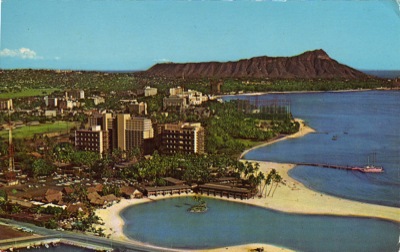
Kaiser’s Hawaiian Village resort in the early 1960s. The pink on the right are catamarans; the radio tower at left is probably for Kaiser’s station, KHVH.
Because of his cement interests, Kaiser had visited Hawaii before the war, but — ever the workaholic — he wasn’t much interested in vacationing. In 1951, however, his wife Bess died. Less than four weeks later, Kaiser stunned his colleagues and shocked Oakland social circles by marrying Bess’ nurse, who was just half his age. Alyce “Ale” Kaiser opened his eyes to new ventures and ideas.
When they visited Hawaii together in 1953, he saw it through the eyes of a young person looking for adventure. They quickly bought a home in Hawaii, and, true to form, Kaiser began looking around for investments, particularly ones that could create jobs for chronically unemployed Hawaiians.
Hawaii in the first half of the twentieth century was dominated by the “Big Five,” a group of companies that owned much of the islands’ land. These companies raised sugar cane on most of the land, providing work for residents that was strictly seasonal. The Big Five resisted unionization as well as any potentially rival employers for island workers.
So picture this: Kaiser is 71 years old. He is nominally in charge of a huge conglomerate of industries on the mainland, including an auto company that is hemorrhaging money. He is a newcomer to Hawaii, a traditionally insular society, and his goals are directly opposed to those of the most powerful interests in the islands. His top lieutenants are busy running his mainland companies and have no time to help him in Hawaii.
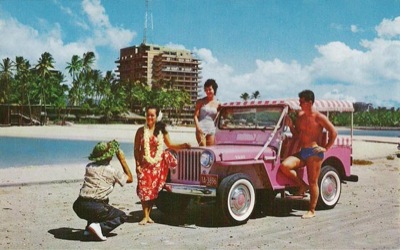
Never hesitant about product placement, Kaiser rented Jeep Surreys to hotel guests. Rumor had it that the hotel painted many things pink because that was Ale’s favorite color. In fact, it was just a successful marketing tool.
Undaunted, Kaiser sets out to create almost from scratch an entirely new industry, one that would provide year-round work for thousands of residents. After considering several possibilities, he decided that tourism was the best choice. So, in partnership with Fritz Burns — the southern California developer who helped Kaiser build Panorama City — Kaiser built the Hawaiian Village Hotel, a destination resort extending over 22 acres of beach front in Waikiki. The resort included both low-rise and high-rise hotel rooms, cottages, and various restaurants and meeting rooms.
A few stories about the hotel illustrate Kaiser’s working principles.
When acquired by Kaiser, the site of the resort already had several cottages rented to tourists. These were relocated to make room for the main hotel buildings. One Friday, a city inspector told Kaiser’s foreman that two of the cottages are 19-1/2 feet apart, when the city building code requires that they be 20 feet apart. The inspector hinted that, for a small bribe, he will overlook the code violation.
When told about the problem, Kaiser directed that work crews spend all weekend removing six inches from one of the cottages. Next Monday, the foreman informed the inspector, “You must have made a mistake in your measurements.” The inspector was increasingly puzzled as he repeated the measurement over and over. Later, the crew let him know what happened. The lesson for island officials: Kaiser would not pay bribes.
Publicity photo of thatched cottages and pool from a 1955 brochure.
The 22 acres on which the hotels were to be constructed were covered with many graceful palm trees. Kaiser issued orders that not a single tree would be killed during construction. Instead, as buildings went up, scores of trees were dug up and replanted in other parts of the resort.
As construction continued, a local union organizer informed Kaiser that he planned to invite Kaiser’s employees to join the union. Kaiser responded that he had no problem with that if they wanted to join. When a majority joined, the organizer returned to ask Kaiser to negotiate a contract.
“Just bring me a contract that you think is fair to both sides,” Kaiser said, “and I’ll sign it.” When the organizer brought the contract, Kaiser turned to the last page to sign.
“Aren’t you even going to read it?” asked the organizer.
“No, I asked you to write a fair contract, one we could look each other in the eye and not be ashamed of,” said Kaiser.
“I just had my boys draw it up,” the organizer hastily responded. “I better check it before you sign.”
A few days later, he returned with the contract, which Kaiser signed unread. After the organizer left, Kaiser handed the contract to his staff, saying, “Better see what I got us into.” It turned out that the contract was fair to all concerned except for one part. In the event of a dispute, most contracts call for an arbitration committee. This one read, “In case of any dispute, Henry Kaiser shall be the sole arbiter and his decision shall be final.”
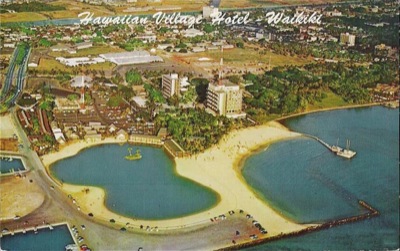
The lagoon shown in the 1957 postcard was made by bringing in hundreds of tons of beach sand.
To enhance Waikiki beach, only a portion of which was naturally sandy, Kaiser proposed to import hundreds of tons of sand. While most of the new beach would be public, he asked permission to close a portion of the beach directly in front of the hotel to all but hotel guests. This was somewhat controversial, but one long-time member of the legislature told Kaiser he would guarantee approval in exchange for a $5,000 bribe. Kaiser politely told him to vote for or against the measure strictly on its merits. The measure was approved.
The hotel finally opened with a gala celebration in September, 1955. But fall is not the prime tourist season in Hawaii, so after the grand opening occupancies were a disappointing 10 percent. This led a 73-year-old Kaiser to travel to the mainland and personally present a slide show to dozens of leading travel agents to sell them on the hotel. Occupancies soon greatly increased. To prod the airlines into increasing service to Hawaii, he threatened to start his own airline — a threat that, coming from him, would have to be taken seriously.
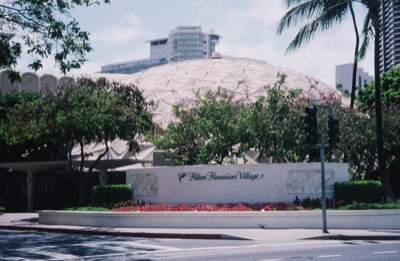
Looking a little out of place in a tropical setting, the Kaiser aluminum geodesic dome was a popular venue for music and theatre for 42 years.
Soon after the hotel opened, Buckminister Fuller began publicizing geodesic domes. Always intrigued by new building concepts, Kaiser ordered his aluminum works to provide the materials for a 49-1/2-foot high, 149-foot diameter dome. These were shipped to the resort and erected in just 20 hours in 1957. Considered the first geodesic dome ever built, the dome was used as an auditorium and theatre for the next four decades. Not surprisingly, Kaiser Aluminum supplied many more geodesic domes for buildings all over the U.S.
To help promote the Hawaiian Village, Kaiser also bought radio and television stations (including KHVH for Hawaiian Village Hotel), selected and promoted singers and other entertainers, and held various sorts of events such as cooking contests, boat races, and movie premieres. One of the first events in the Kaiser geodesic dome was the Hawaiian premiere of the movie, Around the World in 80 Days, attended by director Michael Todd and his wife, Elizabeth Taylor.
When the Kaiser-sponsored television show Maverick went off the air, TV executives tried to interest him in a detective series. He agreed — provided it was located in Hawaii, and Hawaiian Eye, which naturally was set at the Hawaiian Village Hotel, was born. (Ironically, he refused to sponsor Dr. Kildare or Ben Casey because he thought hospital shows were depressing.)
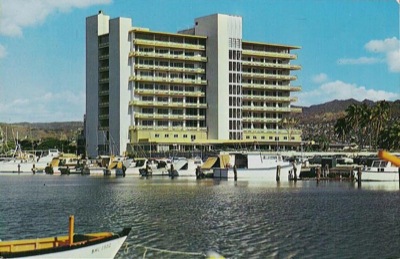
The Kaiser Permanente Hospital in Honolulu.
When Kaiser started building the Hawaiian Village resort, the Hawaiian medical association asked him not to bring his Kaiser health care program, which many doctors then considered “socialized medicine,” to Hawaii. He agreed provided that local doctors would start their own prepaid health-care program. Of course they did not, so in 1958 he built and staffed a Kaiser hospital in just 11 months.
Eventually, his attention turned to other things, and in 1961 Kaiser sold his half interest in the Hawaiian Village to Conrad Hilton. Hilton later bought out Fritz Burns and still owns and operates the resort today (but tore down the geodesic dome in 1999). Last year, Hilton itself was purchased by the Blackstone Group, an investment company that also owns La Quinta Inns.
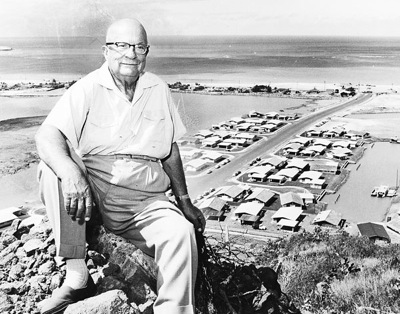
Henry Kaiser above Hawaii Kai in the early 1960s.
In 1959, Kaiser started his next big project: Hawaii Kai, a $350 million model city on 6,000 acres about 12 miles from downtown Honolulu. “Kai” means ocean in Hawaii, and the development featured a marina, beaches, underground power lines, cable television, some of the nation’s first condominiums, thousands of single-family homes, and of course schools, shopping centers, homeowner associations, and all the other essentials for a modern self-contained community of around 30,000 people.
One problem was that the two-lane Kalanianaole Highway between Honolulu and Hawaii Kai was inadequate for the number of people Kaiser planned to live at the development. When the state requested proposals for a study to see whether it should expand the road to four lanes, Kaiser went to the governor and offered to build the four-lane road for the proposed cost of the study. The governor agreed but said the state would have to open up the project to bids. Kaiser got the low bid and within four months the highway was complete for less than the cost of the study.

Hawaii Kai in 1988. Though Kaiser had planned for an eventual population of 50,000 people, urban-growth boundaries have limited the population today to about 30,000.
Flickr photo by Alan Light.
Hawaii Kai sales started slow, but the development was clearly a success by 1967, when Kaiser died at his home in Hawaii at the age of 85. His New York Times obituary reported that Kaiser Industries employed nearly 100,000 people making more than 300 different products at 180 plants and projects in 32 states and 40 foreign countries. The Hawaiian Advertiser reports that his personal worth was $2.5 billion, which — after adjusting for inflation — would put him among the twenty wealthiest Americans today.
Next: Kaiser’s Legacy








Pingback: Henry J. Kaiser, Industrialist » The Antiplanner
http://hutnyak.com/MINExpo/Trucks/Caterpillar.JPG/797/CAT797FrontView1.JPG